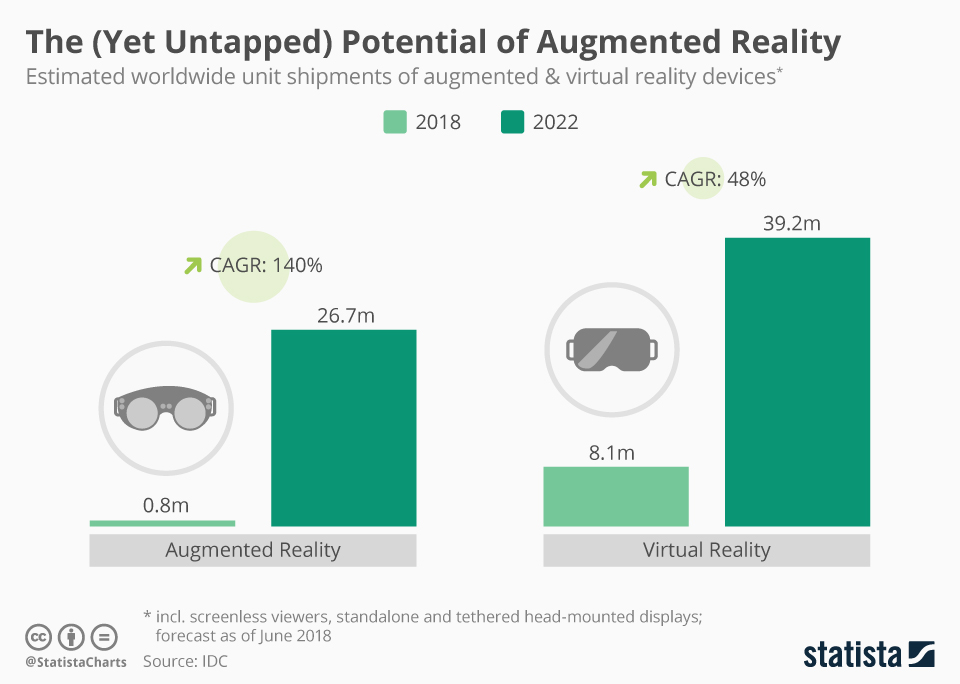Augmented reality (AR) is regularly associated with the gaming industry; its popularity rising in recent years with its applications in games like Ingress and Pokémon Go. Smart Manufacturers have tapped into this new-age technology and expanded its applications to industrial processes, proving to enhance efficiency, reduce costs and production downtime.
Shipments of AR glasses to surpass 150,000 units in 2019, and to reach 2.7 million in 2023. – CCS Insights
Augmented Reality (AR) is Disrupting the Manufacturing Industry
While AR is still in nascent stages and yet to be adopted for mainstream usage, a few large manufacturing firms have successfully implemented AR applications boosting their performance and productivity.
Augmented reality glasses are forecasted to reach around 19.1 million units by 2021, In 2023, the global augmented reality headset shipments are expected to increase to 31.9 million units. – CCS Insights
 With the feature to visualize images and texts, manufacturers have adopted AR to enhance workflow productivity, provide seamless communications, and reduce errors. Here is a more in-depth look into how manufacturers have implemented AR to business operations.
With the feature to visualize images and texts, manufacturers have adopted AR to enhance workflow productivity, provide seamless communications, and reduce errors. Here is a more in-depth look into how manufacturers have implemented AR to business operations.
Product Design Visualization with AR:
Visualization is a significant aspect of product design. Using 3D Augmented Reality applications for product design provides an added advantage and convenience where designers can easily visualize and interact with the design, add or subtract features at the early stages of production, which is more cost-effective.
Enhance Productivity with AR:
In a traditional assembly process, technicians would consult multiple spreadsheets or PDFs, which could be out of date. With AR, manufacturers have transferred assembly data to AR glasses, providing an enhanced field of view, hands-free, voice-controlled instructions. Technicians can view simple or complex assembly processes through AR devices instead of consulting multiple spreadsheets. This increases the accuracy by 96% and speed by 30%. For example, Volvo, in partnership with Microsoft, uses Hololens so that assembly line engineers can see all the various parts and the process to assemble them with AR devices.
AR Maintenance:
With predictive analysis, AR maintenance can help technicians identify faults and services required before it occurs. Mitsubishi has developed an AR-based 3D Model technology used for a variety of operations apart from manufacturing. AR smart glasses for maintenance reduces workload and increases accuracy. Other companies such as elevator manufacturer Thyssenkrupp plans to use Microsoft’s Hololens for AR maintenance.
Quality Assurance:
Quality is one of the critical parameters in the manufacturing sector and one of the prime factors that differentiate businesses from their competitors. Manufacturers have leveraged AR as it adds an extra layer of accurate quality checks, reducing the cost of quality (i.e., Prevention cost, Appraisal cost, Internal Failure, and External Failure costs.). Porsche employs an internal Augmented Reality software for quality assurance of their cars. The luxury car manufacturer uses the AR software to scan and compare the finished products and check them against the required specifications.
Knowledge Management and Training
Instead of traditional training methods, manufacturers use AR devices and applications to enhance training programs, which is more straightforward and cost-effective. With AR, businesses can capture audio and visual information and document processes with clear instructions. It also helps with consulting and gathering data from experts for future use.
Training staff and new employees are easier with up-to-date information, and AR training programs provide additional information with digital text, images, and videos of products, which would otherwise be difficult in traditional learning environments. Smart devices, coupled with AR apps, can provide comprehensive information that presentations and books would not be able to offer. Jaguar Land Rover uses AR applications to train their technicians about their vehicles without removing the vehicle dashboard.
Mixed Reality (MR) and its application in enterprises
While AR presents a digital canvas of content to the user in real-world scenarios, Mixed Reality is a combination of real and virtual world elements, and users can interact with digital content in the real world. While it is making its mark in the industrial applications of Augmented Reality, Microsoft’s Hololens is also disrupting the MR space, allowing users in the real world to interact with digital content around them. With an increase in devices and enterprise applications, MR will gradually get adopted in the industrial sector, creating innovative methods to revolutionize the manufacturing industry.
Conclusion
Though yet to be adopted by the masses, Augmented Reality is here to stay. With the increase of smart devices and wearable for enterprise, AR applications for industries will become more accessible and with the advantages it provides, such as reduced costs, increased productivity, and reduced downtime, more businesses need to shift from the traditional production methods to cutting edge AR technology.
Looking for a Strategic Digital Transformation Partner?